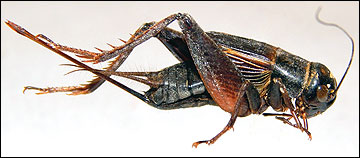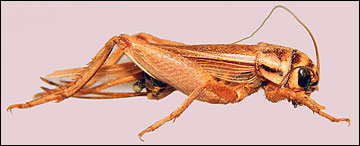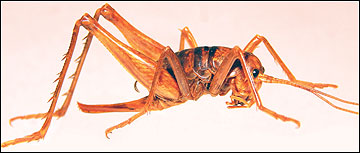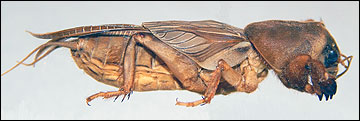Crickets belong to the insect order Orthoptera, which also includes grasshoppers and katydids. The chirping sounds for which they are famous are made by the adult males rubbing their wings together to attract females. Like their grasshopper and katydid relatives, crickets have long hind legs fitted for jumping. In addition, adult females have long, swordlike ovipositors at the tip of their abdomens for laying eggs in the soil.
Crickets will accidentally invade homes, but only rarely will they reproduce there. The usual point of entry is through open or poorly fitted doors, and cracks in doors, windows, foundations or siding. The factors that contribute to cricket invasions, and the damage they cause, vary among cricket species. The most common house-invading crickets in Missouri are field crickets (Gryllus spp.), house crickets (Acheta domesticus), ground crickets (Nemobius fasciatus), camel or cave crickets (Ceuthophilus spp.) and mole crickets (Neocurtilla hexadactyla).
Biology
Field cricket
Several species in the genus Gryllus are called field crickets (Figure 1). They are usually black and vary in length from 0.5 to 1.25 inches. The brownish rear wings project back beyond the front wings like pointed coat tails.
Field crickets invade homes most often during the fall in response to cooler nighttime temperatures. They are also attracted to lights at night, which often brings them near buildings. Once inside, they feed on and cause damage to items such as cotton, linen, wool, silk and fur. Materials soiled by perspiration or food are more likely to be damaged. These crickets also eat dead or dying insects, including their own species. At times, field crickets may also cause damage to field crops.
 Figure 1
Figure 1
Field cricket.
House cricket.
The house cricket (Acheta domesticus) is light yellowish-brown and has three darker brown bands across the head (Figure 2). The adult stage varies in length from 0.75 to 1 inch. During warm weather, house crickets can live outdoors and are especially fond of garbage dumps.
Like the field cricket, house crickets are driven indoors by cool temperatures. All stages are able to live in buildings year-round. Adults are attracted to lights at night. Inside buildings, house crickets are normally found in warm, dark places. They may damage items such as cotton, linen, wool, silk and fur — especially when these items are soiled by perspiration or food.
 Figure 2
Figure 2
House cricket.
Ground cricket
The ground cricket (Nemobius fasciatus) and possibly other species of the genus, are very common in Missouri (Figure 3). They are dark reddish brown to black and vary in length from 0.3 to 0.5 inch as adults.
Ground crickets normally are found outdoors, but lights and the warmth of buildings may cause large-scale indoor invasions. Because of their small size, they find it easier to gain entry than other crickets. They may do damage indoors similar to field crickets. The chirping sound of the male is more shrill and high-pitched than that of field crickets.
 Figure 3
Figure 3
Ground cricket.
Camel cricket
Most species of camel crickets belong to the genus Ceuthophilus (Figure 4). This name describes their humpbacked appearance when viewed from the side. They have jumping hind legs and long antennae like other crickets, but they are wingless and so are unable to chirp. Color varies by species, ranging from light tan to brown, often with dark brown bands on some segments. Adults range from 0.5 to 1.5 inches in length.
Camel crickets are usually associated with cool, damp, dark habitats. Because they are often found in caves, they are also commonly called cave crickets. Outdoors, they may be found under stones and logs and in other cool, damp habitats with suitable amounts of organic matter, which they use for food.
Like other crickets, camel crickets will invade buildings in the fall seeking suitable places to pass the winter. In these cases, they often remain in basements or crawl spaces and seldom damage items in the home. They are usually considered a nuisance only by virtue of their presence.
 Figure 4
Figure 4
Camel cricket.
Mole cricket
Mole crickets are abundant in the southeastern United States, where several species are pests of turfgrass (Figure 5). The northern mole cricket (Neocurtilla hexadactyla) is found in Missouri and is usually considered more of a curiosity than a pest. As the name implies, these crickets look like moles. They are normally light brown and about 1.5 inches long. They have beady eyes, and their shovel-like front legs are short, stout, and used for digging.
Mole crickets live underground, where they tunnel through the soil and feed on plant roots. Unlike other crickets, they are poor jumpers. They are also weak fliers, but they take to the air when their tunnels are flooded. It is during these times that they are found walking across the ground and may enter homes. Although they look frightening, mole crickets are not known to damage anything in the home.
 Figure 5
Figure 5
Mole cricket.
Management
Sanitation. Understanding cricket behavior is important if you want to minimize the risk of household invasion. Remember that crickets prefer to live in dark, protected locations behind or under objects and in cracks or crevices. They generally prefer cool, damp and dark habitats. Large populations may become established around buildings where these conditions are present. Minimize cricket habitat near your home by eliminating rocks, stacked boards, firewood, overgrown vegetation, and other types of clutter.
Most crickets are active at night. Field and house crickets are strongly attracted to lights, but mole crickets are less so. To minimize the attractiveness of your home to these types of crickets, limit the use of outdoor lighting, or use yellow lights, which are less attractive to insects than are white, neon or mercury vapor lights. Camel crickets are not attracted to lights.
Cracks and crevices in and around the foundation are common openings that crickets use to gain entry into homes. They also enter buildings through open or poorly fitting doors, windows and vents. Repairs that eliminate these small openings will greatly minimize the risk of cricket invasions.
Indoor control. Because crickets are large, they are easily captured or killed indoors. Crickets should always be removed after killing them so they don't serve as a food source for other insects, such as ants or beetles. Vacuum cleaners work well for removing living and dead crickets indoors. Sticky traps have also been used successfully to capture and kill crickets, especially the camel cricket.
Cricket baits are particularly effective when applied indoors. Other over-the-counter insecticides can also be used indoors if the label specifically allows. Such insecticides should only be applied in cracks and crevices where crickets are suspected to be hiding. Spraying the air or applying insecticides to large, exposed surfaces is undesirable and mostly ineffective.
Outdoor control. If you have eliminated outdoor cricket habitats and repaired cricket entry points, but still have cricket invasions, insecticide treatments may be applied around the perimeter of your home to create a barrier against cricket invasions. Bait treatments can be especially effective when applied to the soil in a band between cricket habitats and the home.
Liquid insecticides can also be applied to the foundation and soil surface in areas of suspected cricket invasion. Create a treated zone covering an area starting one foot out from the foundation and ending one foot up from the soil surface. You should also apply the insecticide to basement window wells, crawl space vents, and weep holes in brick veneer. Sprays applied to bare concrete are absorbed and are not likely to have much of an effect on invading crickets. In this case, a bait formulation is more effective. Never place baits and liquid barriers together in the same zone.
Various over-the-counter insecticides have been approved for use in and around the house. Most of these are pyretrins and pyrethroids (chemical names ending in –thrin). Select insecticides that have crickets listed on the label. Always follow label directions, especially with regard to correct amounts and recommended methods of application. Follow safety precautions closely, and use recommended safety equipment. Remember that insecticide treatments are only temporary solutions. You may need to repeat this procedure after the insecticide barrier dissipates if crickets continue to invade. You may also choose to hire a professional pest management company if the problem persists.